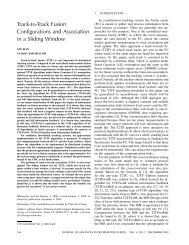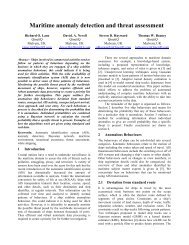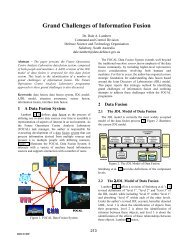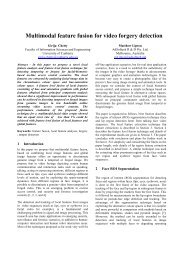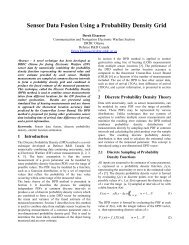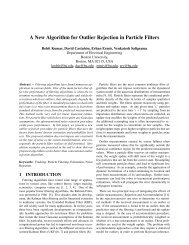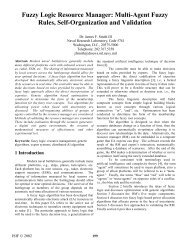Multiple Sensor Multiple Object Tracking With GMPHD Filter - ISIF
Multiple Sensor Multiple Object Tracking With GMPHD Filter - ISIF
Multiple Sensor Multiple Object Tracking With GMPHD Filter - ISIF
You also want an ePaper? Increase the reach of your titles
YUMPU automatically turns print PDFs into web optimized ePapers that Google loves.
1 (x) with measurement set Z1 k by equation (13) to obtain<br />
also a Gaussian mixture. In the case there is one sensor, this the PHD at time k sensor 1, vk 1(x). Because v k 1(x) is a<br />
method can be employed.<br />
Gaussian mixture, vk 1 (x) is also a Gaussian mixture and has<br />
In what follows, we outline the <strong>GMPHD</strong> lter with assumptions<br />
the form<br />
vkjk 1 Jk 1 = (J k 1 + J ;k )(1 + jZkj) 1 (20)<br />
there are no spawning objects. (In the case there<br />
JkX<br />
1<br />
are spawning objects, the prediction equation is modied<br />
vk(x) 1 = w (i)<br />
1;kN(x; m(i)<br />
1;k ; P (i)<br />
1;k ) (14)<br />
by adding Gaussian components representing for spawning<br />
i=1<br />
objects. The details is in [12]).<br />
Now, at the sensor 2, we use vk 1 (x) as the predicted PHD for<br />
Under assumptions in IV-A, the predicted intensity to time the sensor 2 and in the similar way to (13), we have<br />
k is given by<br />
v<br />
v kjk 1 (x) = v S;kjk 1 (x) + k (x) (11)<br />
k(x) 2 = (1 p D;k )vk(x) 1 + X<br />
v D;k (x; z) (15)<br />
z2Zk<br />
2<br />
where<br />
So, v<br />
J<br />
X k 1<br />
k 2 (x) also have the Gaussian mixture form.<br />
v S;kjk 1 (x) = p S;k w (j)<br />
k 1N(x; m(j)<br />
S;kjk 1 ; P (j)<br />
S;kjk 1 );<br />
JkX<br />
2<br />
j=1<br />
vk(x) 2 = w (i)<br />
2;kN(x; m(i)<br />
2;k ; P (i)<br />
2;k ) (16)<br />
m (j)<br />
S;kjk 1<br />
= F k 1 m (j)<br />
k 1 ;<br />
i=1<br />
P (j)<br />
S;kjk 1<br />
= Q k 1 + F k 1 P (j)<br />
k 1 F k T We repeat this process with Q sensors. At the Qth sensor, we<br />
1:<br />
obtained v Q k<br />
(x), and it has the form<br />
Because v S;kjk 1 (x) and k (x) are Gaussian mixtures,<br />
J<br />
v kjk 1 (x) can be expressed as a Gaussian mixture of the form<br />
kX<br />
Q<br />
v Q k (x) = w (i)<br />
Q;kN(x; m(i)<br />
Q;k ; P (i)<br />
Q;k ) (17)<br />
J kjk<br />
X 1<br />
v kjk 1 (x) = w (i)<br />
kjk 1N(x; m(i)<br />
kjk 1 ; P (i)<br />
i=1<br />
kjk 1 ) (12) The PHD for the multi-sensor multi-object posterior density<br />
i=1<br />
will be<br />
Then, the posterior intensity at time k is also a Gaussian<br />
v k (x) = v Q k<br />
(x) (18)<br />
mixture, and is given by<br />
v k (x) = (1 p D;k )v kjk 1 (x) + X<br />
The number of objects is estimated by<br />
v D;k (x; z) (13)<br />
Z<br />
z2Z k ^N kjk = v k (x)dx<br />
where<br />
J kjk<br />
X 1<br />
Z JkX<br />
Q<br />
v D;k (x; z) = w (j)<br />
k<br />
(z)N(x; m(j)<br />
kjk ; P (j)<br />
kjk );<br />
= w (i)<br />
Q;kN(x; m(i)<br />
Q;k ; P (i)<br />
Q;k )dx<br />
j=1<br />
i=1<br />
w (j)<br />
k (z) = p D;k w (j)<br />
kjk 1 q(j) k<br />
(z)<br />
JkX<br />
Q<br />
P<br />
= w (i)<br />
Jkjk<br />
k (z) + p<br />
1<br />
D;k l=1<br />
w (l)<br />
kjk 1 q(l) k<br />
(z);<br />
Q;k<br />
i=1<br />
(19)<br />
q (j)<br />
k (z) = N(z; H km (j)<br />
kjk 1 ; R k + H k P (j)<br />
kjk 1 HT k ); So, the properties of the Gaussian mixture in the case of<br />
m (j)<br />
kjk<br />
= m (j)<br />
kjk 1 + K(j) k (z H km (j)<br />
kjk 1 );<br />
multi-sensor is similar with one sensor case. This means in the<br />
multi-sensor multi-object tracking problem, under assumptions<br />
P (j)<br />
kjk<br />
= [I K (j)<br />
k<br />
H k]P (j)<br />
kjk 1 ;<br />
in IV-A, the initial prior intensity of multi-sensor multi-object<br />
tracking is a Gaussian mixture, the posterior intensity for<br />
K (j)<br />
k<br />
= P (j)<br />
kjk 1 HT k (H k P (j)<br />
kjk 1 HT k + R k ) 1 : asynchronous sensor fusion method at any subsequent time<br />
C. <strong>GMPHD</strong> lter with multi-sensor<br />
step is also a Gaussian mixture.<br />
When there are many sensors, we propose a method to D. Implement issues<br />
solve by using <strong>GMPHD</strong> lter sequentially at each sensor. The<br />
The state estimations of objects are the means of Gaussian<br />
algorithm is described as follows.<br />
components that have high weights (above 0.5) in v<br />
<strong>With</strong> assumptions in IV-A, at time k 1 we have<br />
k (x). This<br />
estimation method is more efcient than particle PHD lter.<br />
J<br />
X k 1<br />
Because in particle PHD lter, we obtain the number of objects<br />
v k 1 (x) = m (i)<br />
k 1N(x; w(i)<br />
k 1 ; P (i)<br />
k 1 )<br />
^N kjk then partition particles into ^N kjk clusters. If ^N kjk is not<br />
i=1<br />
First, we used assumptions on state equation (5), measurement<br />
corrected, then the tracking performance will be affected.<br />
Now, we investigate the number of Gaussian components in<br />
equation (6) and v k 1 (x) to predict the intensity vkjk 1 1 (x) v k (x). At the rst sensor, the number of Gaussian components<br />
at the sensor 1 by using the equation (11). Then we update is


